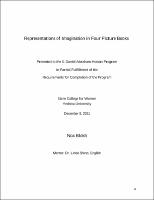Please use this identifier to cite or link to this item:
https://hdl.handle.net/20.500.12202/7896| Title: | Representations of Imagination in Four Picture Books |
| Authors: | Shires, Linda Blokh, Noa |
| Keywords: | picture books imagination |
| Issue Date: | 8-Dec-2021 |
| Citation: | Blokh, Noa. (2021, December 8), Representations of Imagination in Four Picture Books, (Undergraduate honors thesis, Yeshiva University). |
| Series/Report no.: | S. Daniel Abraham Honors Student Theses;December 8, 2021 |
| Abstract: | Although the content of picture books can be written off as merely for children, picture books are possibly the most impactful books written because of the impressionable age at which they are first read (Nel 87), and thus, if we hope to foster a strong sense of imagination within children, then their literature must emphasize that value. The four books examined above are exemplars of quality texts about imagination. Each provides a slightly different flavor and take on imagination, yet all encapsulate the same imaginative spirit, as defined by Greene (49). Harold and the Purple Crayon is an abstraction of imaginative exploration and emphasizes the use of imaginative tools such as a crayon. Where the Wild Things Are demonstrates how imagination can be used to work through hard emotions and how the line between reality and imagination can become blurred, while Frederick shows how creative talents can be used to help others. Lastly, What Do You Do with an Idea? captures the process, potency, and universality of imagination through one boy’s creative process.¶ Thus far we have emphasized picture book’s impact on children, yet their impact is much larger. Picture books contain beauty, wisdom, and relevance for readers of all ages, and are enjoyed by readers far past childhood (Nel 88). For example, Philip Nel, a contemporary scholar of children’s literature, writes that Harold and the Purple Crayon’s “presentation of the imagination as a source of power and possibility” was a great source of comfort for him as a teenager while navigating the experience of a new school, and that he was inspired by the idea “that I could find my place in the world simply by imagining it” (89). Just as Philip Nel found meaning in Harold and the Purple Crayon later in life as well as when young, the complexity of each book’s representation of imagination allows meaning for all readers-- in whatever stage or situation of life they may find themselves. After all, imagination is the power to conceive of life differently and transcend reality for a bigger and better future, and that undoubtably is a message for all people. (from Conclusion) |
| Description: | Undergraduate honors thesis / Open Access |
| URI: | https://hdl.handle.net/20.500.12202/7896 |
| Appears in Collections: | S. Daniel Abraham Honors Student Theses |
Files in This Item:
| File | Description | Size | Format | |
|---|---|---|---|---|
| Noa Engle Blokh Honors Thesis Picture Books OA Dec2021.pdf | 1.4 MB | Adobe PDF |  View/Open |
This item is licensed under a Creative Commons License

